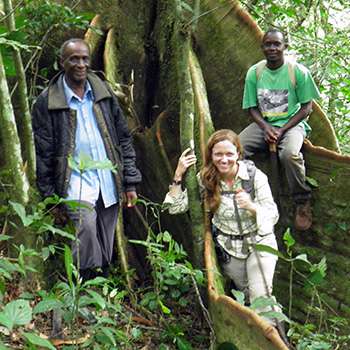Blogging from Africa: Researcher to study endangered chimpanzees and their shrinking habitat in fragmented forests

In late September, USC Dornsife Ph.D. student Maureen McCarthy traveled 9,000 miles from Los Angeles to Hoima, Uganda, to begin a year devoted to collecting chimpanzee poop.
While that may seem like an unusual way to spend a year, McCarthy will be building a specimen collection that will form the foundation for new research on the endangered primates.
A doctoral student in USC Dornsife's Integrative and Evolutionary Biology (IEB) graduate program, McCarthy hopes to help unlock urgent mysteries about how chimpanzees cope with their dwindling habitat. She is tracking genetic patterns within and between the scattered forest fragments that these chimps now call home. Readers can follow McCarthy's scientific adventure by reading her blog on the Scientific American website at blogs.scientificamerican.com/expeditions/ and at dornsife.usc.edu/panoramic-perspectives/.
Before her departure, Maureen said she was eager to begin her yearlong fieldwork in Uganda.

"After several years of preparation, including two pilot data collection trips and many hours of reading and proposal-writing, it feels a bit surreal to begin data collection at last," she said. "I'm excited to test hypotheses that will help us better understand the lives of chimpanzees in fragmented forests, and to find solutions that will aid their conservation."
McCarthy's blog will explore everyday life in Uganda while also taking readers deep into the tropical rain forest as her team searches for and documents chimp nests.
Collecting stool samples and later analyzing their DNA to determine whose stool it is will enable McCarthy to determine how chimps migrate through forest fragments and, more importantly, whether they migrate between them at all.
To date, most research on chimpanzees has occurred in protected forest reserves, which, by comparison, are vast and unbroken. The problem is that increasing numbers of chimps live in dwindling and isolated fragments of forest as small as a few acres.
"Deforestation and habitat fragmentation have taken an enormous toll on wildlife both in Uganda and around the world," she said. "Studies of genetics and habitat fragmentation ecology are becoming increasingly crucial to help determine impacts and possible solutions for chimpanzees, as well as a wide range of other species."
McCarthy's year in Uganda will be followed by a year at the Max Planck Institute for Evolutionary Anthropology in Leipzig, Germany, where she will process her samples and prepare to publish her findings.
McCarthy is a student of Craig Stanford, professor of biological sciences, and co-director of the USC Jane Goodall Research Center, housed in USC Dornsife.
"As African forests are chopped into fragments through deforestation, it's imperative that we learn how this process affects wildlife," Stanford said. "Maureen McCarthy's project studies the population genetics of chimpanzees living in tiny satellites of forest amid a growing sea of farms and villages, and should provide the most detailed scientific analysis of how these endangered apes change land use patterns in response to human disturbance."
Provided by University of Southern California


















